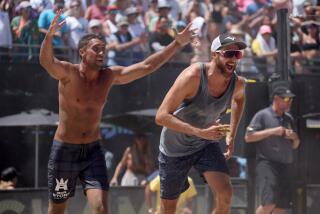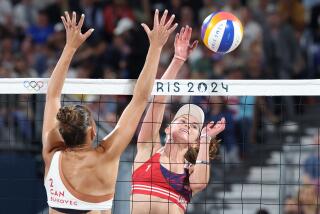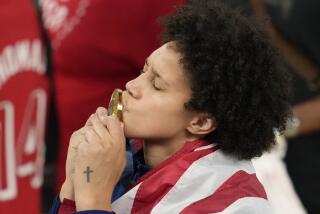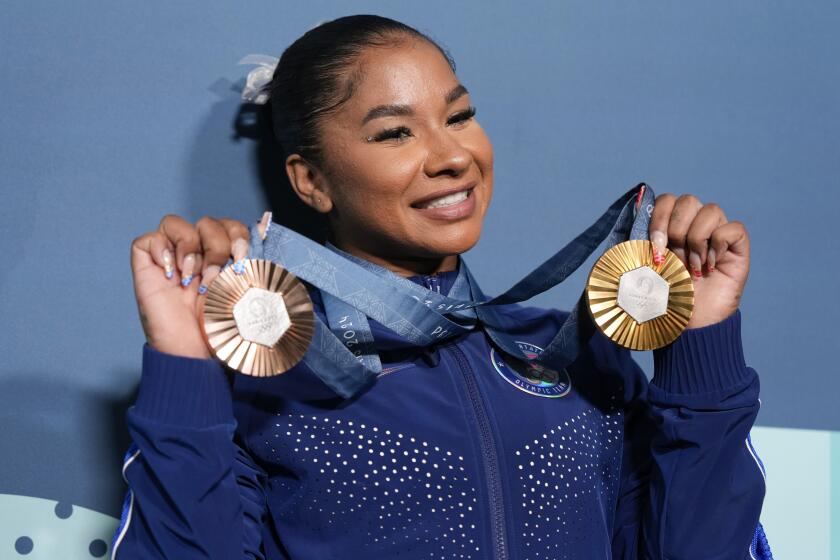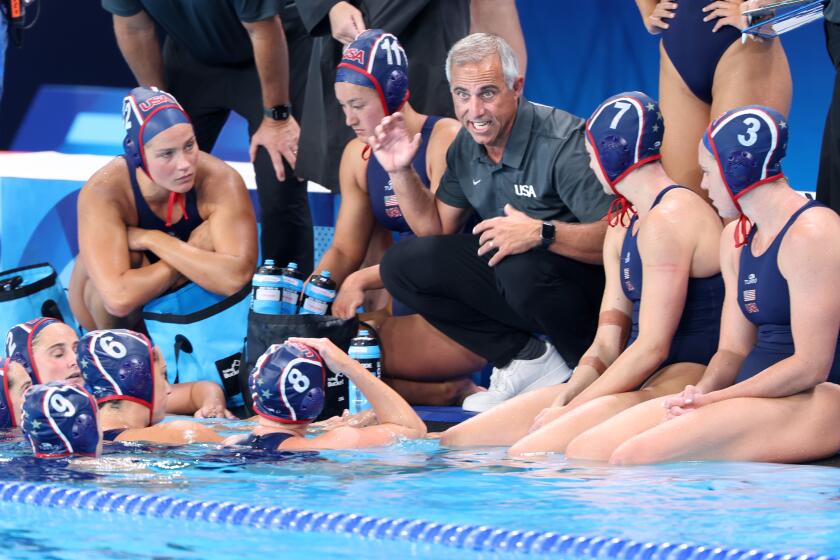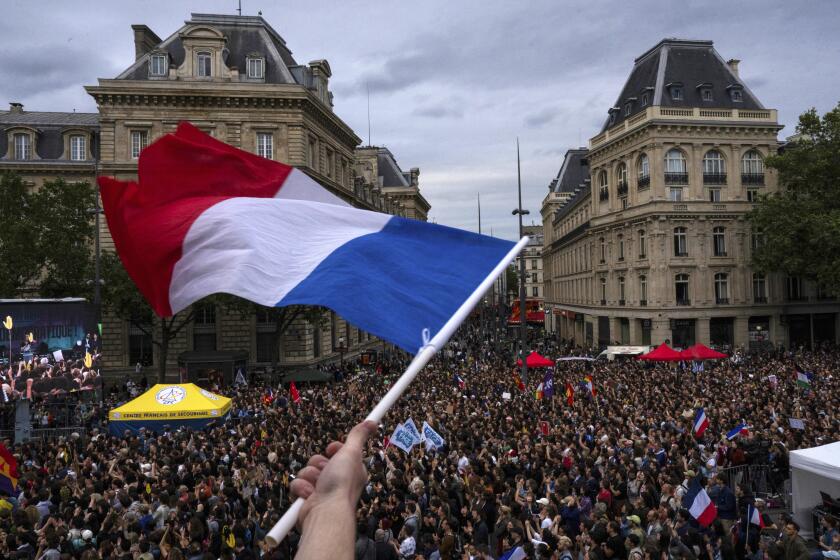U.S. volleyball’s Clay Stanley wields a serve and a stare
Clay Stanley’s 80-mph jump serve is one of the most potent weapons in international volleyball. And as a right-side hitter, he may be the best in the world.
But when U.S. national team Coach Alan Knipe is asked what Stanley brings to the court, the first thing he mentions is “the stare.”
“He has the ability to look right through his teammates,” Knipe says.
And more often than not, Knipe says, those teammates get the message.
“It’s time to go,” Knipe says. “The guys respond to him because they know he’s their leader.”
Just a month ago, the U.S. — the defending Olympic champion — faced the real possibility of missing the London Games after its leader underwent arthroscopic surgery on his left knee, then saw his comeback hindered by a strained triceps and a pulled hamstring. Less than two weeks before last month’s NORCECA continental qualifier, which the U.S. had to win to advance to London, Stanley still hadn’t gone through a full series of workouts with the team.
Knipe started him anyway and Stanley wound up being named most valuable player when the U.S. rolled through the tournament unbeaten.
“It says a lot about how good he is as a player,” says middle blocker Ryan Millar. “And then how focused he was on his recovery and the amount of work that he put in. Pretty impressive.”
But then Stanley’s career has been a series of impressive performances. Although the final U.S. roster for London hasn’t been named, barring another injury Stanley is certain to become a three-time Olympian. Four years ago in Beijing he led the U.S. to its first volleyball gold medal in two decades, winning MVP honors while leading the tournament in scoring and aces. He is also the only repeat winner of USA Volleyball’s indoor male athlete of the year award, which he’s received the last two years. And with his club team in Russia he won the Indesit Champions League in 2008, capturing MVP honors there as well.
Add all that together and Stanley is arguably one of the four best volleyball players in his family. And that’s high praise given the fact that his father, two-time Olympian Jon Stanley, is in the Volleyball Hall of Fame; mother Sandra Haine played for the Canadian national team and professionally in the International Volleyball Assn.; and step-grandfather Tom Haine was on the 1968 Olympic team.
That makes Jon and Clay the first father-son Olympians in U.S. volleyball history. And like his father, a standout basketball player at Brigham Young, Clay Stanley came to the sport late.
His high school in Hawaii didn’t have a volleyball team, so Stanley spent most of his teen years skateboarding. As a senior he dabbled in basketball, leading his team to the state tournament, and water polo — he made an all-star team as a goalie. But his family background wasn’t lost on college coaches. UCLA was among the schools that recruited him to play volleyball, although Stanley decided to stay home, enrolling at the University of Hawaii instead.
He wound up appearing in just 22 matches his first two years at Hawaii, then skipped his senior season altogether to play professionally, first in Puerto Rico and later in Europe.
Four years later he was in the Athens Olympics.
The biggest player on the U.S. team at 6 feet 9 and 230 pounds, Stanley plays a position called the opposite, so named because that player is placed opposite the setter in the rotation. It’s arguably the most demanding spot on the court, requiring size, quickness, the skill to both pass and block at the net and the quick thinking necessary to get points off broken plays such as a bad set or a weak pass. Millar says Stanley aces all of those — as well as serving, at which he is the best on the U.S. team.
If things seemed to come quickly and easily to Stanley early in his career, though, that changed last December when he twisted his knee playing in the FIVB World Cup in Japan. Three days before Christmas he underwent surgery and shortly after that he was back in the gym, working with athletic trainer Aaron Brock and strength coach Tim Pelot.
“I’ve never seen anything like it,” Knipe says. “He was in here eight hours a day getting rehab and lifting. And he’s in the best shape of his life right now. A lot of guys wouldn’t have been able to do what he did. It was pretty impressive. But absolutely not surprising when we’re talking about Clay.”
Stanley, 34, said being sidelined by injury for the first time in his career was both good and bad. Good because it gave him some downtime to rest his body — a rare luxury in volleyball, where the turnaround between the professional season in Europe and playing for the national team is often measured in hours, not weeks or months.
“It was great to be home,” he says. “I got to do a lot of things with my family. I got engaged … [and] I got to do it at home with all my family around.”
Yet the downtime also led him to second-guess whether he was actually hurting the team by trying to come back too soon.
“My issue was ‘Will I be ready? Should I even be playing?’” he says.
He answered both questions in resounding fashion in the NORCECA tournament at Long Beach State. Next up are the Olympics, where the defending gold medalists will face a 12-nation field led by Brazil, the world’s No. 1 team in the most recent FIVB world rankings. The U.S. is ranked sixth, behind Russia, Italy, Poland and Cuba.
That may be misleading, though, because none of those teams have “the stare.” And after taking five months off to refocus, Stanley’s glare could be even more powerful in London, says teammate Reid Priddy.
“Every time you get injured you realize the things that you take for granted. So when you get back on the court you are thankful. It’s always a time for you to just take a step back and kind of get a different perspective,” says Priddy, an outside hitter who preceded Stanley as team captain.
“The best aspect of Clay’s leadership is he wants to do the action first and talk later. More importantly, he’s going to be ready in the big moments. That’s where his leadership really shines.”
More to Read
Go beyond the scoreboard
Get the latest on L.A.'s teams in the daily Sports Report newsletter.
You may occasionally receive promotional content from the Los Angeles Times.
